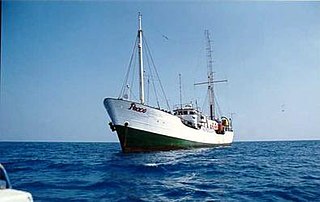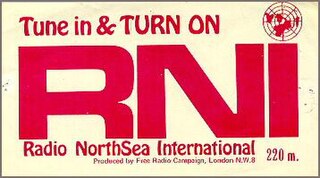
Pirate radio or a pirate radio station is a radio station that broadcasts without a valid license.

The Marine, &c., Broadcasting (Offences) Act 1967, shortened to Marine Broadcasting Offences Act or "Marine Offences Act", became law in the United Kingdom at midnight on Monday 14 August 1967. It was subsequently amended by the Wireless Telegraphy Act 2006 and the Broadcasting Act 1990. Its purpose was to extend the powers of the Wireless Telegraphy Act 1949, beyond the territorial land area and territorial waters of the UK to cover airspace and external bodies of water.

Radio London, also known as Big L and Wonderful Radio London, was a top 40 offshore commercial station that operated from 23 December 1964 to 14 August 1967, from a ship anchored in the North Sea, three and a half miles (5.6 km) off Frinton-on-Sea, Essex, England.
Pirate radio exists in most countries in Europe.
Radio Newyork International was the name of a pirate radio station which broadcast from a ship anchored in international waters off Jones Beach, New York, United States in 1987 and 1988. The history of Radio Newyork International (RNI) is linked with the Falling Star Network and other New York City area pirate radio stations. The owner of RNI, Allan Weiner, is currently the licensee of WBCQ shortwave in Monticello, Maine.
Radio Atlanta was an offshore commercial station that operated briefly from 12 May 1964 to 2 July 1964 from a ship anchored in the North Sea, three and a half miles off Frinton-on-Sea, Essex, England. The radio broadcasting vessel was owned, at that time, by Gordon McLendon and Clint Murchison of Dallas, Texas, and leased to a British company for day-to-day operations. It was named after Atlanta, Texas,
Radio Scotland was an offshore pirate radio station broadcasting on 1241 kHz mediumwave, created by Tommy Shields in 1965. The station was on the former lightship L.V. Comet, which had been fitted out as a radio station in Guernsey using RCA technology and engineers, it was anchored at locations off Scotland, usually outside territorial waters.
Swinging Radio England ("SRE") was a top 40 offshore commercial station billed as the "World's Most Powerful" that operated from 3 May 1966 to 13 November 1966 from a ship in the North Sea, four and a half miles off Frinton-on-Sea, Essex, England. While the station was dubbed a pirate radio station, its operation took place within the law and its offices were in the West End of London. Its representation was by a company formed earlier in the year to represent in Europe the ABC radio and television stations of the United States.

Radio City was a British pirate radio station broadcasting from Shivering Sands Army Fort, one of the abandoned Second World War Maunsell Sea Forts in the Thames Estuary.

Radio Veronica was an offshore radio station that began broadcasting in 1960, and broadcast offshore for over fourteen years. It was set up by independent radio, TV and household electrical retailers in the Netherlands to stimulate the sales of radio receivers by providing an alternative to the Netherlands state-licensed stations in Hilversum.

Voice of Peace was an offshore radio station that broadcast in the Middle East for 20 years from the former Dutch cargo vessel MV Peace, anchored off the Israeli coast in the Eastern Mediterranean. Founded by Abie Nathan and the New York-based Peace Ship Foundation, the station broadcast almost continuously between 19 May 1973 and November 1993. The station was relaunched but solely as an online station in August 2009. A second online channel called The Voice of Peace Classics was added in 2014.

Manx Radio is the national commercial radio station for the Isle of Man. It began broadcasting on 29 June 1964, almost ten years before legal commercial radio was licensed in the United Kingdom. The Isle of Man, having its own government and laws, was not subject to the rules prohibiting commercial broadcasting in the UK. However, the Manx Government still had to apply to the UK's General Post Office for a frequency and for permission to broadcast. First requested in 1960, a licence was eventually granted in May 1964. It was allocated an FM frequency of 89.0 MHz and a comparatively low power of 50 watts. In October 1964, an additional frequency of 1594 kHz AM was allocated to the station to provide greater coverage, although again at a limited power of 50 watts. It broadcasts primarily in English with several hours per week of Manx language programming.

MV Ross Revenge is a radio ship, the home of Radio Caroline, as well as having supported Radio Monique and various religious broadcasters. Funded by the Icelandic government, she was constructed in Bremerhaven in 1960 and served as an Icelandic commercial trawler until 1963 when she was sold to the Ross Group fleet, notably taking part in the Cod Wars of the 1970s. Following her decommissioning, she was purchased by Radio Caroline and outfitted as a radio ship, complete with 300-foot (91 m) antenna mast and 50 kW transmitter. Her broadcasts began on 20 August 1983; her final pirate broadcast took place in November 1990. She ran aground on the Goodwin Sands in November 1991, bringing the era of offshore pirate radio in Europe to an end. She was, however, salvaged, and is now maintained by the Caroline Support Group, a group of supporters and enthusiasts.
Radio Caroline is a British radio station founded in 1964 by Ronan O'Rahilly and Alan Crawford initially to circumvent the record companies' control of popular music broadcasting in the United Kingdom and the BBC's radio broadcasting monopoly. Unlicensed by any government for most of its early life, it was a pirate radio station that never became illegal as such due to operating outside any national jurisdiction, although after the 1967 Marine Broadcasting Offences Act it became illegal for a British subject to associate with it.
Caroline Overdrive was a programming strand which ran on British radio station Radio Caroline in 1986–1987.

Radio North Sea International was a European offshore radio station run by the Swiss firm Mebo Telecommunications, jointly owned by Swiss engineer Edwin Bollier and his business partner, Erwin Meister. RNI broadcast for less than five years in the early 1970s and, courting both disaster and success, made a modest financial profit.
Radio Luxembourg was a multilingual commercial broadcaster in Luxembourg. It is known in most non-English languages as RTL.
Radio Atlantis was a Belgian-owned offshore pirate radio station, which operated in 1973 and 1974 from the coast of The Netherlands and Belgium. The station began broadcasting from the Radio Caroline ship MV Mi Amigo on 15 July 1973. The station was owned by Belgian businessman Adriaan van Landschoot who ran a chain of companies all named Carnaby:
Radio Monique was an offshore radio station broadcasting to the Netherlands and Belgium from the Radio Caroline ship, MV Ross Revenge.

Mi Amigo was originally a three-masted cargo schooner, that later gained international recognition as an offshore radio station. She was built as the schooner Margarethe for German owners. A sale in 1927 saw her renamed Olga and she was lengthened in 1936. During the Second World War, she was requisitioned by the Kriegsmarine and served as an auxiliary ship between 1941 and 1943. In 1953, the ship was again lengthened to 133 feet 9 inches (40.77 m). In 1959, she was sold for conversion to a floating radio station and was renamed Bon Jour. Subsequently, she was renamed Magda Maria in 1961 and Mi Amigo in 1962. She served, intermittently, as a radio ship, until 1980, when she sank in a gale.










